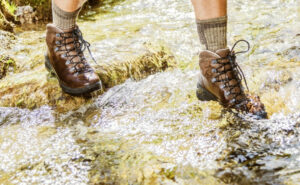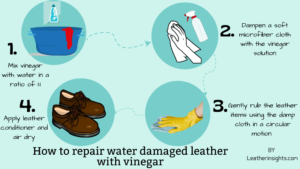How to repair water damaged leather (the RIGHT way!)
We saw in our previous article that water is leather’s worst enemy.
When leather that has been in contact with water begins to dry, it loses its natural oils and becomes brittle and stiff, which causes it to crack or peel. Have you experienced this?
In this post, we’ll show you how to repair water-damaged leather products, including shoes, bags, wallets, coats, and boots.

How to repair water damaged leather
To repair water damaged leather, start by wiping off the excess water with a soft cloth and then air dry it at room temperature. Once the leather has dried, moisturize it with the right leather conditioner to maintain suppleness and prevent it from stiffening up. Lastly, keep your leather items in a cool, dry place.
1. Rubbing alcohol to remove water stains
Rubbing alcohol is a combination of isopropyl alcohol and water. It is often used as a mild cleaning solvent or agent and disinfectant.
While alcohol-based solutions are not recommended for cleaning leather, rubbing alcohol is considered safe especially when mixed with water.
Apart from removing water stains and spots, rubbing alcohol also disinfects leather items.
To remove the water stains from your leather item, follow these steps;
- Dilute 2 parts rubbing alcohol with 3 parts water
- Dab a cotton ball or dampen a soft microfiber cloth with the diluted rubbing alcohol
- Rub the water stains until they disappear. Remember to rub gently so as not to strip off the protective finish on the leather surface.
- Rinse off by lightly dampening another clean cloth in water and wiping the leather gently
- Let the leather air dry before moisturizing with a suitable leather conditioner to prevent the leather from drying out.
2. Moisturize with a leather conditioner
Another option is to moisturize your water-damaged leather with a suitable leather conditioner.
This is particularly important if water has caused your leather items to crack, flake or peel.
The conditioner gets deep into the leather fibers and rehydrates them. This causes the leather to soften and stops it from cracking.
Follow the following steps to condition your leather items;
- Air your leather product to make sure it is completely dry
- Get a leather conditioner like Leather Honey, which is designed to penetrate deep into the leather fibers to rehydrate and moisturize the leather.
- Place a small amount of the conditioner onto a clean lint-free cloth
- Rub it gently onto the leather in a circular motion
- Once done, take a dry soft cloth and buff the leather
- Leave it to air dry before using it
- You might need to re-condition the leather after 6 months to make sure it remains well moisturized.
3. Use vinegar to clean leather damaged by mold
If you notice black or white spots on your leather items, it could be mold or mildew.
Vinegar, rubbing alcohol, or baking soda can be used on leather to eliminate mold. We’ll show you how to use vinegar to eliminate mold from leather in this part.
Vinegar is a powerful household cleaner that eliminates odors and removes stains from surfaces. However, it must be diluted when cleaning leather in order to avoid stripping off the protective finish.
Step 1: Dilute one part vinegar with one part water
Step 2: Dampen a soft microfiber cloth with the vinegar solution
Step 3: Gently rub the moldy parts using the damp cloth in a circular motion until the mold is gone
Step 4: Once done, wipe the leather down with a clean cloth
Step 5: Apply conditioner to moisturize the leather and let it air dry.

How to identify water damage leather
As we have already mentioned here, leather is porous, so it absorbs water and soaks easily. If this happens, your leather goods may as a result develop mold, crack, peel, or stain and discolor.
-
Mold growth
Leather can sustain more severe damage if it becomes wet or damp because it fosters the growth of mold and mildew.
Additionally, improper leather storage, particularly in wet or moist environments, promotes the growth of mold.
It’s therefore important to take early action if you notice moisture or water damage on your leather.
You have a better chance of salvaging your leather items if you begin the drying and cleaning procedure quickly.
-
Stains and discolorations
As the water dries out on the leather surface, it leaves behind water spots or marks that can be difficult to get rid of.
Water may also soak into the leather and shift the dye leaving streaks and patches in addition to discoloration.
The best solution to prevent water stains and marks from forming on leather is by wiping off the spills and any water drops immediately.
-
Cracking and flaking
Leather is made of animal skin and in order to maintain its suppleness, it must be adequately moisturized, just like our own skin.
However, when exposed to water, the natural oils in the leather mix with water and evaporate as the leather dries. This makes it brittle and prone to cracking, peeling, and flaking.
If you notice your leather product that has been exposed to water is beginning to crack, the best remedy is to condition and moisturize it to replenish the lost oils. This is a perfect way to fix a peeling leather sofa, shoes, or coat.
Conclusion
In this article, we have talked about how to repair water damaged leather using rubbing alcohol, leather conditioner, and vinegar.
Rubbing alcohol is an effective cleaning solvent that can be used to remove mold, water spots, and stains on leather. You can also get rid of mold on leather using vinegar or baking soda.
Moisturizing water-damaged leather is also highly recommended in order to prevent drying out which causes cracking and peeling.
In summary, consider the following to prevent your leather items from getting damaged by water.
- Dry the leather immediately comes into contact with water
- Do not dry leather in direct sunlight to prevent drying out
- Apply a suitable leather conditioner to restore dry leather
- Do not store leather items in damp areas to prevent mold growth
- Always dilute household cleaners like vinegar and rubbing alcohol before using them on leather





